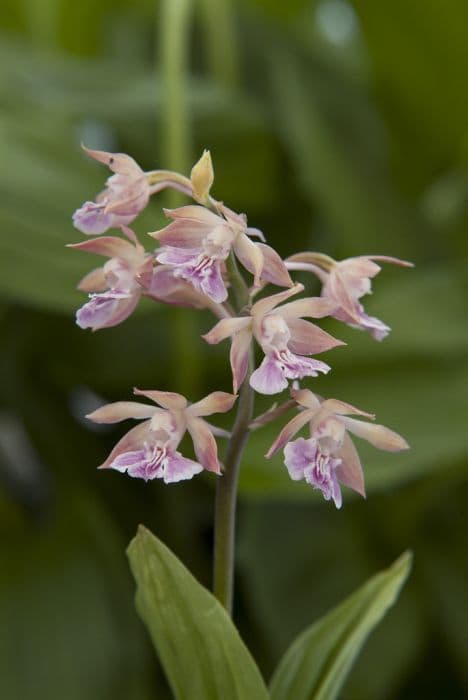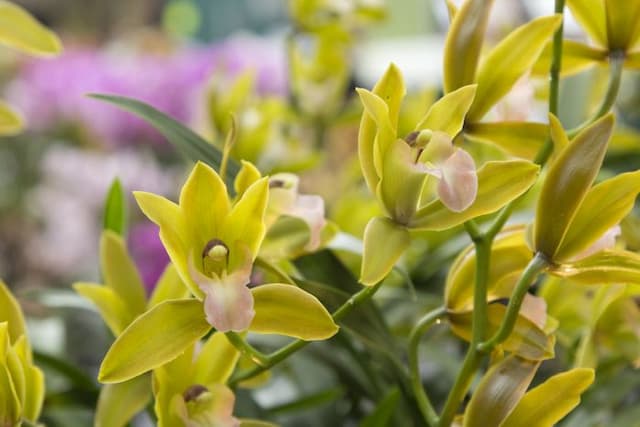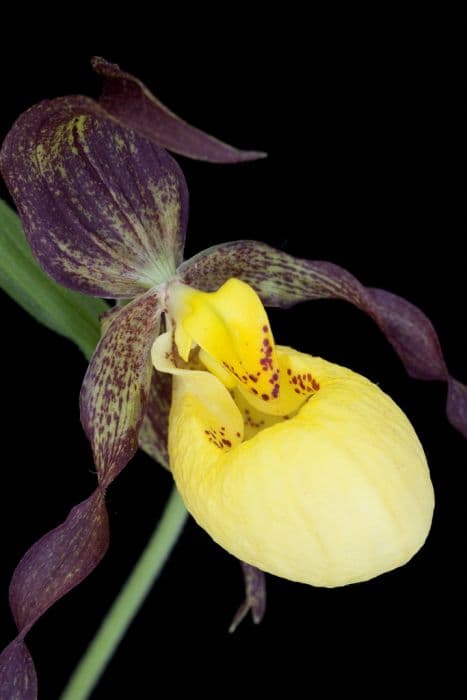Long-leafed Stenoglottis Stenoglottis longifolia
ABOUT
Stenoglottis longifolia, commonly known as the Long-Leaf Stenoglottis, is an orchid notable for its distinct foliage and flower characteristics. The leaves are lance-shaped and pleated, presenting a lush green color with a somewhat leathery texture. These leaves often form a rosette at the base of the plant, providing an attractive foundation for the blooms. The flowers of the Long-Leaf Stenoglottis are small and intricate, typically showcasing a beautiful combination of purple and white. They are arranged on a slender, elongated spike that emerges from the center of the leaf rosette. Each flower spike carries numerous blossoms that can create an impressive floral display when the plant is in full bloom. This orchid's blooms possess a delicate appearance, with the petals arranged in a symmetrical fashion, contributing to its ornamental appeal. The contrast between the vivid purple flowers and the green foliage makes this plant a striking addition to any collection. Despite the prolific nature of its blossoms, the overall visual impact of the plant is one of elegance and daintiness, reflective of its exotic heritage.
About this plant
 Names
NamesFamily
Orchidaceae
Synonyms
Long-Leaf Stenoglottis, Strap-Leaved Stenoglottis
Common names
Stenoglottis longifolia.
 Toxicity
ToxicityTo humans
Stenoglottis longifolia, commonly known as the Orchid, is not widely known to be toxic to humans. There is limited information on the toxicity of this specific orchid to humans, but most orchids are generally considered non-toxic. However, it is important to note that individual allergies and sensitivities can occur with any plant, and it is always best to avoid ingesting plants that are not specifically meant for human consumption to prevent any potential adverse effects.
To pets
Stenoglottis longifolia, commonly referred to as the Orchid, is also not widely recognized as being toxic to pets. The majority of orchid species are considered non-toxic to cats and dogs. However, as with humans, individual pets may have allergies or sensitivities to plants. If a pet ingests a part of this orchid and exhibits any unusual symptoms, it is advisable to consult a veterinarian. Generally, ingestion of orchids by pets does not result in serious poisoning or health consequences.
 Characteristics
CharacteristicsLife cycle
Perennials
Foliage type
Evergreen
Color of leaves
Green
Flower color
Pink
Height
1 foot [30 cm]
Spread
1 foot [30 cm]
Plant type
Herb
Hardiness zones
9
Native area
South Africa
Benefits
 General Benefits
General Benefits- Ornamental value: Stenoglottis longifolia, also known as the Spotted Orchid, has attractive purple-spotted flowers that enhance the visual appeal of gardens and home environments.
- Habitat enrichment: It can contribute to the biodiversity of a garden, providing habitat and resources for pollinators.
- Long flowering period: The Spotted Orchid blooms for an extended period, offering a long-lasting display of flowers.
- Easy propagation: It can be easily propagated, allowing gardeners to share and spread the plant among enthusiasts.
- Drought tolerance: Once established, this orchid is relatively drought-tolerant, reducing the need for frequent watering.
- Educational interest: As an orchid species, it can be used to educate about plant biology and the diversity within the Orchidaceae family.
- Cultural significance: Orchids have various cultural meanings and symbolism, often associated with love, luxury, and beauty.
 Medical Properties
Medical PropertiesThis plant is not used for medical purposes.
 Air-purifying Qualities
Air-purifying QualitiesThis plant is not specifically known for air purifying qualities.
 Other Uses
Other Uses- Orchid Collection Addition: Stenoglottis longifolia, commonly known as Spotted or Harlequin Orchid, can be grown as a part of a specialized orchid collection for its attractive leaves and delicate flowers.
- Botanical Studies: This species can be used in botanical studies due to its interesting pollination mechanisms and adaptation to specific ecological niches.
- Educational Resource: The Spotted Orchid is suitable for educational purposes, teaching students and hobbyists about orchid care and propagation.
- Bee Attractant: It can serve as a natural attractant in gardens for bees and other pollinating insects, aiding in the local ecosystem's pollination process.
- Photography Subject: Its unique flowers make it a great subject for nature photographers and plant enthusiasts who document plant biodiversity.
- Floral Arrangements: Although not commonly used, its blooms could potentially be used in floral arrangements when flowers are in season.
- Gifting Plant: Due to its appealing appearance, the Spotted Orchid can make for an interesting and exotic gift for plant lovers.
- Horticultural Shows: This orchid can be displayed in horticultural shows, adding diversity with its South African origins.
- Conservation Efforts: Stenoglottis longifolia may be propagated by enthusiasts aiming to conserve rare or less common orchid species.
- Vertical Gardens: With its ability to grow in minimal soil, it can be included in vertical garden installations, often in semi-shaded areas.
Interesting Facts
 Feng Shui
Feng ShuiThe plant Stenoglottis longifolia, commonly known as the Hard-leaved Orchid, is not used in Feng Shui practice.
 Zodiac Sign Compitability
Zodiac Sign CompitabilityThe Hard-leaved Orchid is not used in astrology practice.
 Plant Symbolism
Plant Symbolism- Resilience: Stenoglottis longifolia, being an orchid that thrives in diverse conditions from forests to mountainous areas, represents resilience and an ability to adapt to changing environments.
- Rare Beauty: As a less commonly seen orchid, the Stenoglottis longifolia symbolizes unique and rare beauty, reminding us to appreciate the uncommon and extraordinary.
- Persistence: The growth habit of this plant, often persevering in tough conditions, stands for persistence and the determination to grow and thrive against the odds.
- Grace: With its elegant flowers and delicate presence, this plant conveys a sense of grace and finesse, often associated with the sophisticated beauty of orchids.
 Water
WaterThe Stenoglottis longifolia, commonly known as the Long-leafed Stenoglottis, prefers even moisture during active growth, meaning it should be watered thoroughly once the top inch of the soil begins to feel dry to the touch. On average, this might equate to watering every 5 to 7 days, but this can vary depending on environmental conditions such as temperature and humidity. When watering, use lukewarm water, applying it directly to the soil until it runs out of the bottom of the pot, indicating the roots have received enough moisture. Avoid letting the plant sit in standing water. During its dormancy period, after blooming, reduce watering to every other week, or enough to prevent the potting medium from completely drying out, requiring perhaps a few ounces to maintain slight moisture.
 Light
LightLong-leafed Stenoglottis enjoys bright, indirect light but should be protected from the harsh direct afternoon sun. A spot near an east or west-facing window where the plant is exposed to bright, diffused light is ideal. If grown indoors, ensure that the light is bright enough to cast a shadow without scorching the leaves; sheer curtains can help filter the light adequately.
 Temperature
TemperatureThe Long-leafed Stenoglottis thrives in temperatures between 50 to 75 degrees Fahrenheit. It can tolerate short periods of cooler temps down to about 40 degrees Fahrenheit, but it shouldn't be exposed to frost. Conversely, temperatures above 80 degrees Fahrenheit can stress the plant, so it is essential to keep it in a spot where the temperature remains relatively consistent and within the ideal range.
 Pruning
PruningPruning is not a routine care requirement for the Long-leafed Stenoglottis. However, you may remove spent flower spikes after blooming to tidying the plant and encourage new growth. Cut the flower stalk close to the base without damaging the foliage. Pruning is best done immediately after the flowers have faded.
 Cleaning
CleaningAs needed
 Soil
SoilThe best soil mix for Stenoglottis longifolia, commonly known as the Long-leafed Stenoglottis, should have good drainage and retain some moisture. A suitable mix might include equal parts of loamy soil, fine bark, and perlite. The soil pH should be slightly acidic to neutral, ranging between 5.5 and 7.0.
 Repotting
RepottingThe Long-leafed Stenoglottis should be repotted every 2-3 years or when it outgrows its pot. It's best to repot this plant in the spring, just before its active growing period begins.
 Humidity & Misting
Humidity & MistingLong-leafed Stenoglottis thrives in high humidity conditions; the ideal humidity level for this plant ranges between 40-70%. Always aim for the higher end of this range if possible.
 Suitable locations
Suitable locationsIndoor
Provide bright light, high humidity, and good air circulation.
Outdoor
Shelter from direct sun, in dappled shade, and protect from frost.
Hardiness zone
9-11 USDA
 Life cycle
Life cycleThe life cycle of Stenoglottis longifolia, commonly known as the Long-leafed Stenoglottis, begins with germination, where the tiny seeds, lacking any endosperm, rely on a symbiotic relationship with mycorrhizal fungi to provide essential nutrients. Following germination, seedlings establish themselves, developing a rosette of strap-like leaves. As the plant matures, it enters a vegetative growth stage where it continues to produce more leaves and grows in size, preparing for reproduction. Annual flowering typically occurs in late summer or fall, with the plant producing a tall inflorescence bearing numerous small, appealing, purple-spotted flowers that are pollinated by insects. After pollination, seeds are produced within capsules that eventually dry and split open to release the dust-like seeds, completing the reproductive cycle. The plant may also propagate vegetatively through offshoots at the base, gradually forming larger clumps over time.
 Propogation
PropogationPropogation time
Spring-Early Summer
The most popular method of propagating Stenoglottis longifolia, known commonly as the Long-leaved Stenoglottis, is by dividing its pseudobulbs during the rest period after the plant has finished flowering. This is ideally done in the spring, just as new growth is beginning to appear. A healthy clump is carefully taken out of the pot, and the medium is removed from the roots. Using a sterile cutting tool, the clump is then divided into smaller sections, ensuring that each section has at least one pseudobulb and some roots. The divisions are potted up in small pots using a well-draining orchid medium and should be kept in a humid environment until they establish and new growth is evident.









